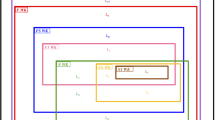Abstract
Watson–Crick (WK) finite automata are working on a Watson–Crick tape, that is, on an abstract construct similar to DNA molecules. Therefore, it has two reading heads. While in traditional WK automata both heads read the whole input in the same physical direction, in \(5'\rightarrow 3'\) WK automata the heads start from the two extremes and read the input in opposite direction. In sensing \(5'\rightarrow 3'\) WK automata the process on the input is finished when the heads meet. Since the heads of a WK automaton may read longer strings in a transition, in previous models a so-called sensing parameter took care for the proper meeting of the heads (not allowing to read the same positions of the input in the last step). In this paper, a new model is investigated, which works without the sensing parameter (it is done by an appropriate change of the concept of configuration). Consequently, the accepted language classes of the variants are also changed. Various hierarchy results including six sublinear language classes and closure properties are proven in the paper.










Similar content being viewed by others
Explore related subjects
Discover the latest articles, news and stories from top researchers in related subjects.References
Adleman LM (1994) Molecular computation of solutions to combinatorial problems. Science 226:1021–1024
Amar V, Putzolu GR (1964) On a family of linear grammars. Inform Control 7:283–291
Csuhaj-Varjú E, Freund R, Vaszil Gy (2015) A connection between red-green turing machines and Watson–Crick T0L Systems. MCU 31–44
Czeizler E, Czeizler EA (2006) Short survey on Watson–Crick automata. Bull EATCS 88:104–119
Freund R, Păun G, Rozenberg G, Salomaa A (1997) A Watson–Crick finite automata, In: 3rd DIMACS Sympozium On DNA Based Computers, Philadelphia, pp. 305–317
Hegedüs L, Nagy B, Egecioglu Ö (2012) Stateless multicounter \(5^{\prime } \rightarrow 3^{\prime }\) Watson–Crick automata: the deterministic case. Nat Comput 11(3):361–368
Hopcroft JE, Ullman JE (1979) Introduction to automata theory, languages and computation. Addison-Wesley, Boston
Kocman R, Nagy B, Krivka Z, Meduna A (2018) A jumping \(5^{\prime } \rightarrow 3^{\prime }\) Watson–Crick finite automata model. NCMA 2018: Tenth workshop on non-classical models of automata and applications, Kosice, Slovakia, pp. 117–132
Kuske D, Weigel P (2004) The role of the complementarity relation in Watson–Crick automata and sticker systems, In: Developments in language theory, DLT 2004, Lecture Notes in Computer Science, LNCS 3340, Springer, Berlin, Heidelberg, pp. 272–283
Leupold P, Nagy B (2010) \(5^{\prime } \rightarrow 3^{\prime }\) Watson–Crick automata with several runs. Fundam Inform 104:71–91
Loukanova R (2007) Linear context free languages. In: Jones C, Liu Z, Woodcock J (eds) ICTAC 2007. LNCS 4711. Springer, Heidelberg, pp. 351–365
Nagy B (2007) On \(5^{\prime } \rightarrow 3^{\prime }\) sensing Watson–Crick finite automata, DNA13: The 13th International Meeting on DNA Computing (Preliminary proceedings), Memphis, Tennessee, USA, pp. 327–336
Nagy (2008) On \(5^{\prime } \rightarrow 3^{\prime }\) sensing Watson–Crick finite automata, In: Garzon MH, Yan H (Eds): DNA Computing. DNA 2007: Selected revised papers, Lecture Notes in Computer Science, LNCS 4848, Springer, Berlin, Heidelberg, pp. 256–262
Nagy B (2009) On a hierarchy of \(5^{\prime } \rightarrow 3^{\prime }\) sensing WK finite automata languages, In: Computaility in Europe, CiE 2009: mathematical theory and computational practice, Abstract Booklet, Heidelberg, pp. 266–275
Nagy B (2010) \(5^{\prime } \rightarrow 3^{\prime }\) Sensing Watson–Crick Finite Automata, pp. 39–56, In: Gabriel Fung (ed.): Sequence and Genome Analysis II – Methods and Applications, iConcept Press
Nagy B (2013) On a hierarchy of \(5^{\prime } \rightarrow 3^{\prime }\) sensing Watson–Crick finite automata languages. J Logic Comput 23(4):855–872
Nagy B (2020) \(5^{\prime } \rightarrow 3^{\prime }\) Watson–Crick pushdown automata. Inform Sci 537:452–466
Nagy B (2021) \(5^{\prime } \rightarrow 3^{\prime }\) Watson–Crick pushdown automata. Nat Comput. https://doi.org/10.1007/s11047-021-09865-z
Nagy B, Kovács Z (2019) On simple \(5^{\prime } \rightarrow 3^{\prime }\) sensing Watson–Crick finite-state transducers, NCMA 2019: Eleventh Workshop on Non-Classical Models of Automata and Applications, Valencia, Spain, 155–170
Nagy B, Otto F (2020) Linear Automata with Translucent Letters And Linear Context-Free Trace Languages, RAIRO Theoretical Informatics and Applications - RAIRO ITA 54 , article number 3 (23 pages)
Nagy B, Parchami Sh (2021) On deterministic sensing \(5^{\prime } \rightarrow 3^{\prime }\) Watson–Crick finite automata: a full hierarchy in 2detLIN, Acta Informatica 58, pp. 153–175 (2021)
Nagy B, Parchami Sh, Sadeghi HMM (2017) A new sensing \(5^{\prime }\rightarrow 3^{\prime }\) Watson–Crick automata concept, AFL 2017, Proceedings 15th International Conference on Automata and Formal Languages, EPTCS 252, pp. 195–204
Păun Gh, Rozenberg G, Salomaa A (2002) DNA Computing: New Computing Paradigms, Springer-Verlag
Rosenberg AL (1967) A machine realization of the linear context-free languages. Inform Control 10:175–188
Rozenberg G, Salomaa A (eds) (1997) Handbook of formal languages. Springer, Berlin
Sears D, Salomaa K (2012) Extended Watson–Crick L systems with regular trigger languages and restricted derivation modes. Nat Comput 11(4):653–664
Sempere JM (2004) A representation theorem for languages accepted by Watson–Crick finite atomata. Bull EATCS 83:187–191
Sempere JM (2018) On the application of Watson–Crick finite automata for the resolution of bioinformatic problems, NCMA 2018 (invited talk), pp. 29–30
Acknowledgements
A part of the results of this paper were presented in AFL 2017 in Debrecen, Hungary Nagy et al. (2017). Comments of the anonymous reviewers are gratefully acknowledged.
Author information
Authors and Affiliations
Corresponding author
Additional information
Publisher's Note
Springer Nature remains neutral with regard to jurisdictional claims in published maps and institutional affiliations.
Rights and permissions
About this article
Cite this article
Nagy, B., Parchami, S. \(5'\rightarrow 3'\) Watson–Crick automata languages-without sensing parameter. Nat Comput 21, 679–691 (2022). https://doi.org/10.1007/s11047-021-09869-9
Accepted:
Published:
Issue Date:
DOI: https://doi.org/10.1007/s11047-021-09869-9




